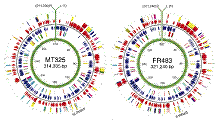Virology, Nebraska Center for
Document Type
Article
Date of this Version
5-1-2005
Abstract
Here we present complete genome sequences, including a comparative analysis, of 103 isolates of foot-and-mouth disease virus (FMDV) representing all seven serotypes and including the first complete sequences of the SAT1 and SAT3 genomes. The data reveal novel highly conserved genomic regions, indicating functional constraints for variability as well as novel viral genomic motifs with likely biological relevance. Previously undescribed invariant motifs were identified in the 5’ and 3’ untranslated regions (UTR), as was tolerance for insertions/deletions in the 5’ UTR. Fifty-eight percent of the amino acids encoded by FMDV isolates are invariant, suggesting that these residues are critical for virus biology. Novel, conserved sequence motifs with likely functional significance were identified within proteins Lpro, 1B, 1D, and 3C. An analysis of the complete FMDV genomes indicated phylogenetic incongruities between different genomic regions which were suggestive of interserotypic recombination. Additionally, a novel SAT virus lineage containing nonstructural proteinen-coding regions distinct from other SAT and Euroasiatic lineages was identified. Insights into viral RNA sequence conservation and variability and genetic diversity in nature will likely impact our understanding of FMDV infections, host range, and transmission.


Comments
Published in JOURNAL OF VIROLOGY, May 2005, p. 6487–6504 Vol. 79, No. 10. 0022-538X doi:10.1128/JVI.79.10.6487–6504.2005 Copyright © 2005, American Society for Microbiology. Used by permission.